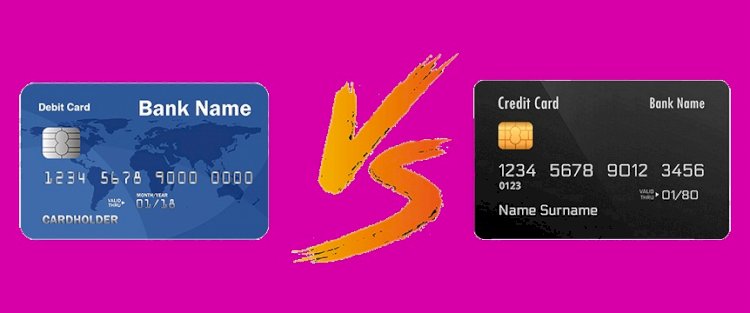Difference Between Debit Card and Credit Card
The major difference is that with a credit card, the bank lends you money to use which you can use and pay them back with interest on a monthly basis where as Debit cards draw money directly from your checking account when you make the purchase.

Debit Card
A debit card (also known as a bank card, plastic card or check card) is a plastic payment card that can be used instead of cash when making purchases.It is a payment card that deducts money directly from a consumer’s checking account to pay for a purchase. Debit cards eliminate the need to carry cash or physical checks to make purchases directly from your savings. In addition, debit cards also known as check cards.
Debit cards do not allow the user to go into debt, except perhaps for small negative balances that might be incurred if the account holder has signed up for overdraft protection. Debit cards usually have daily purchase limits, meaning it may not be possible to make an especially large purchase with a debit card.
Debit cards serve a dual purpose:
They allow the user to withdraw money from his or her checking account through either an ATM or the cash-back function many merchants offer at the point of sale. In addition, they also allow the user to make purchases.
There are currently three ways that debit card transactions are processed: EFTPOS (also known as online debit or PIN debit), offline debit (also known as signature debit), and the Electronic Purse Card System.
Credit Card
A credit card is a thin rectangular piece of plastic or metal issued by a bank or financial services company, that allows cardholders to borrow funds to pay for goods and services with merchants that accept cards for payment.
Credit cards impose the condition that cardholders pay back the borrowed money, plus any applicable interest, as well as any additional agreed-upon charges, either in full by the billing date or over time.The card issuer (usually a bank) creates a revolving account and grants a line of credit to the cardholder, from which the cardholder can borrow money for payment to a merchant or as a cash advance.
Here’s the basic difference between the Debit card and Credit card:-
|
Basis of distinction |
Credit Card |
Debit Card |
|
Definition |
Money can be used on credit to pay for goods and services and has to be repaid at a later date to the lending institution or the bank. |
The money is directly debited from your checking account and credited to the service provider’s account via debit card payment. |
|
Types |
Standard credit card, reward card, secured credit card, charge card |
Standard debit card, prepaid debit card , Electonic benefits transfer(EBT) |
|
Source of fund |
The credit card company pays the vendor for the purchase. |
Funds are tansferred from your saving bank account or current account. |
|
Withdrawal Terms |
Monthly and daily credit limits based on cash withdrawals with card. |
Daily limits on spends and cash withdrawals |
|
Spending advantage |
You can spend more than what you have. |
You can spend how much you have. |
|
Bill |
You get a bill or statement each month with the details of the transaction you have made. |
There is no bill, you get statement for you purchase via sms or e-mail. |
|
Payments |
A bill needs to be paid each month since it is being borrowed. |
There is no payment needed that needs to be made since you are using your own money. |
|
Fees |
Credit cards have multiple fees applicable. These include joining fees, annual fees, late payment fees, and bounced cheque fees among others. |
Annual fees and PIN regeneration fees are applicable |
|
Charges |
Interest rate applicable on the outstanding amount along with annual fees an service taxes. |
No mandtory fee however a few banks may charge an annual fee. |
|
Interest |
Credit Cards come with up to 50-days of interest free credit. To avoid interest, you must pay your outstanding amount by the due date. |
There is no interestcreit limit rate charged as the amount is paid directly out of your account. |
|
Limits to the funds that can be accessed |
You can use the card only up to the pre-set credit limit on your card. |
You can access any amount up to what is currently avaliable in your savings or current account. |
|
EMI Facility |
It easily provides EMI option. This can be done in two ways - paying off the entire principal without any interest and other is to pay a small portion now and carry the rest amount to the future by paying interest. |
A few e-commerce sites and some banks offer EMI options on debit cards. But when you purchase the money is first debited from your bank account and subsequently reversed in two working days. The EMI starts after 30 days from the date of reversal. |
|
Loan against card |
Depending on the issuing bank, you can take a short term loan against the credit card for tenure of 3-24months. |
Loan facility is not avaliable against debit cards. |
|
Benefits |
Most credit cards offer you a wide range of rewards,cash benefits and perks including cashbacks, discounts and other feaatures like free flights and exciting gifts. |
Few debit cars offer reward and benefit such as discount and cashback. |
|
Credit score |
Timely payments of dues has a positive impact and could bolster your credit score. |
Does not effect credit history. |
|
Annual fees |
Depends on the type of card. |
Low to nil |
|
Eligibilty |
It has basic eligibilty criteria based on income, existing relationship and creditworthiness |
You can get a Debit Card easily if you have a savings or current account. |
|
Fraud protection |
Funds are not withdrawn immediately,you may be protected from fraud and theft.If you misplace your card, you may be able to temporarily lock it via mobile or online banking. |
You may be asked to enter a Personal Identification Number (PIN) to authorize purchases. If you misplace your card, you may also be able to temporarily lock it via mobile or online banking. |
|
Security feature |
They have security features like SMS notification, PIN and OTP but comes with zero liability insurance for lost and stolen card. |
It has security features like SMS notification, PIN and OTP. |
|
Liabilty of lost or stolen card |
Most cards have zero liability protection for fraudulent purchases. You may report the theft/loss in a timely manner to dispute fraudulent charges |
$50 maximum if you notify the bank within two days of learning the card is missing. After that, liability may increase to $500. Notice must be given within 60 of your statement being sent to you. After 60 days, the liability is unlimited. |
|
Reimbursement |
You may be reimbursed for goods that are damaged in transit. |
If goods are damaged, you likely need to deal with the merchant. |

 Arindam Deshmukh
Arindam Deshmukh 



















